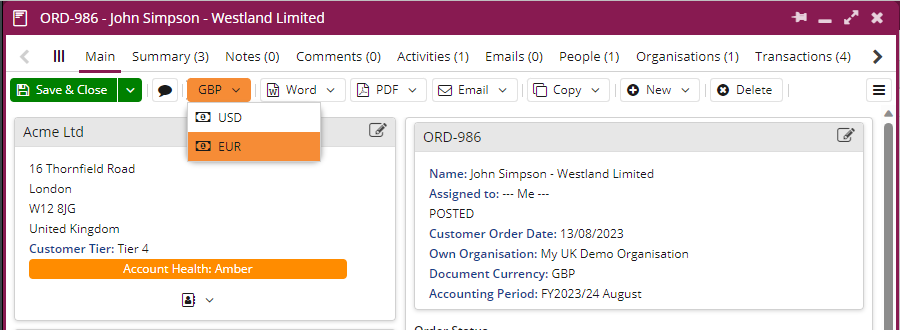Knowledgebase articles
- Welcome to the Knowledge Base
- Introduction
- Training
- Getting Started
- Preferences
- Activities
- Cases
- Importing Data
- Leads
- Marketing
- Introduction to Marketing
- Marketing Campaigns
- Mailing Lists
- Products
- Mailshots
- Upload Library
- Templates
- Event Management
- Compliance Records
- Force24
- Spotler Integration
- What is Spotler?
- Navigating your Spotler homepage
- GatorMail
- GatorLeads / Web Insights
- Tracking Code
- Setting up the Plugin
- Viewing Web Insights Data on your Form Layouts
- Domain Names and Online Activities
- Reporting incorrect Leads created through Web Insights
- Reporting on Web Insights data
- Using UTM Values
- Why aren’t Online Activities being created in the database?
- Why is GatorLeads recording online activities in a foreign language?
- GatorSurvey
- GatorWorkflow
- GatorPopup
- Opportunities
- Projects
- Integrations
- Mapping
- Electronic Signing Tools
- Creditsafe Integration
- Zapier
- Introduction to Zapier
- Available Triggers and Actions
- Linking your Workbooks Account to Zapier
- Setting up Zaps
- Posted Invoices to Xero Invoices
- Xero payments to Workbooks Tasks
- New Case to Google Drive folder
- New Case to Basecamp Project
- New Workbooks Case to JIRA Ticket
- Jira Issue to new Case
- 123FormBuilder Form Entry to Case
- Eventbrite Attendee to Sales Lead and Task
- Facebook Ad Leads to Sales Leads
- Wufoo Form Entry to Sales Lead
- Posted Credit Note to Task
- QuickBooks Online
- Survey Monkey responses to Tasks
- Multistep Zaps
- Email Integrations
- Event & Webinar Integration Tools
- GoToWebinar
- ON24
- Microsoft Office
- Outreach
- Installation
- Outreach Authentication
- Sync People to Outreach Prospects
- Sync Organisations to Outreach Accounts
- Sync Workbooks Opportunities to Outreach
- Sync Tasks/Activities from Workbooks to Outreach
- Sync Outreach Sequences to Workbooks
- Sync Outreach Sequence States to Workbooks
- Sync Outreach Sequence Step Numbers to Workbooks
- Sync Prospects/Accounts/Opportunities from Outreach to Workbooks
- Sync Outreach Tasks/Calls/Meetings to Workbooks
- Scribe/Workbooks Connector
- RingCentral
- Auditing
- Comments
- People & Organisations
- Reporting
- Introduction to Reporting
- Using Reports
- Introduction to Charts
- Exporting Reports
- Advanced Reporting
- Report Snapshots
- Dashboards
- Transaction Documents
- Introduction to Transaction Documents
- Displaying & Adding Transaction Documents
- Copying Transaction Documents
- Transaction Documents Fields Help
- Transaction Documents Line Items Help
- Printing & Sending Transaction Documents
- Managing Transaction Document Currencies
- Managing Transaction Document Statuses
- Setting a Blank Default Currency on Transaction Documents
- Credit Notes
- Customer Orders
- Invoices
- Quotations
- Supplier Orders
- Contract Management
- Sagelink
- Introduction to Transaction Documents
- Configuration
- Introduction to System Administration
- Users & Security
- Database
- Accounting
- Email Integrations
- Customisation
- Creating & Modifying Picklists
- Theme
- Record Types
- Creating Custom Fields
- Report-based Custom Fields
- Linked Fields & Reference Fields
- Record Templates
- Form Layouts
- Customising relationships between parties
- Opportunity Stages
- Custom Records
- Sign In Customisation
- Automation
- Contact Support
- Releases & Roadmap
Managing Transaction Document Currencies
How to manage the currencies in Workbooks, including the difference between the Home Currency and a Foreign Currency.
As part of the Workbooks configuration, each of the Own Organisation should be set up with a home currency and a list of permitted foreign currencies.
Definitions:
Tip
Remember to review your Exchange Rates periodically.
- Home Currency – this is the currency on which the financial management of an Own Organisation is based. The home or base currency is normally the same as that of the country in which the Own Organisation is registered.
- Foreign Currency – this is any currency which is not the home currency of the Own Organisation.
Exchange Rates between each of the home currencies and all of the foreign currencies also need to be set at the time of configuration and should be maintained regularly to reflect the latest rates of exchange.
When creating Transaction Documents, such as a Quotation or an Invoice, the Own Organisation, (which will determine the home currency for the document) and the document currency itself, must be set. If the logged-in User is associated with more than one Own Organisation then they will be presented with a choice. The document currencies will be restricted to the allowed currencies for the Own Organisation selected.
If an Invoice, for example, is POSTED with an Exchange Rate which is different to a subsequent receipt or payment to settle the Invoice, then the difference between the two values, assuming the payment is in full, can be considered as an exchange loss or gain.
When an Invoice is POSTED, the Document Currency can still be changed via a Button at the top of the Record displaying the current currency. Clicking on the button will reveal a drop-down menu of the available currencies. A currency must have an Exchange Rate configured to appear on this list:

When a new Currency is selected, there is an option to either keep the numerical values the same, changing the currency, or to convert these values using the configured Exchange Rate. These changes will applied to the Line Items of the Transaction Document:
